At 10.00 am we present ourselves at the border. We had not paid attention, from Livingstone we have to enter Zimbabwe for a few kilometres and only pass through Botswana. We go to the health desk, a proper PCR test is required. We don’t have one and it’s not possible to do a quick test at the border. The official explains to us: “You have to go to the hospital in Livingstone to take the sample, you’ll get the result tomorrow”, he leaves a pause as if to gauge our reaction and then adds: “Is it OK for you to wait until tomorrow? We told him that we would prefer to have everything settled today. He said, “For 1,000 pulas each and a photo of your passport I can have two official negative test results for you by 2pm without taking a sample. We chose this solution. As for the previous borders we continue through immigration and customs. At about 3pm we leave the Zambian customs.
We take the famous bridge to Zimbabwe. Here we are at the Zimbabwean customs. One: health post, we present the PCR test, it’s OK; two: emigration, stamp on the passport and 50 dollars for the visa, payable only in cash; three: customs for motorbikes, 11 $ per motorbike for the road tax, although the two counters are next to each other, only this one accepts payments by bank card. We stay for a good hour while the rather pretty but particularly unfriendly employee encodes all the data and fills in the two customs books. Finally we leave the office, put on our helmets and gloves and go to the exit gate. There we are signalled to park on the side, another formality to be completed. It’s almost 5pm when we leave the customs.
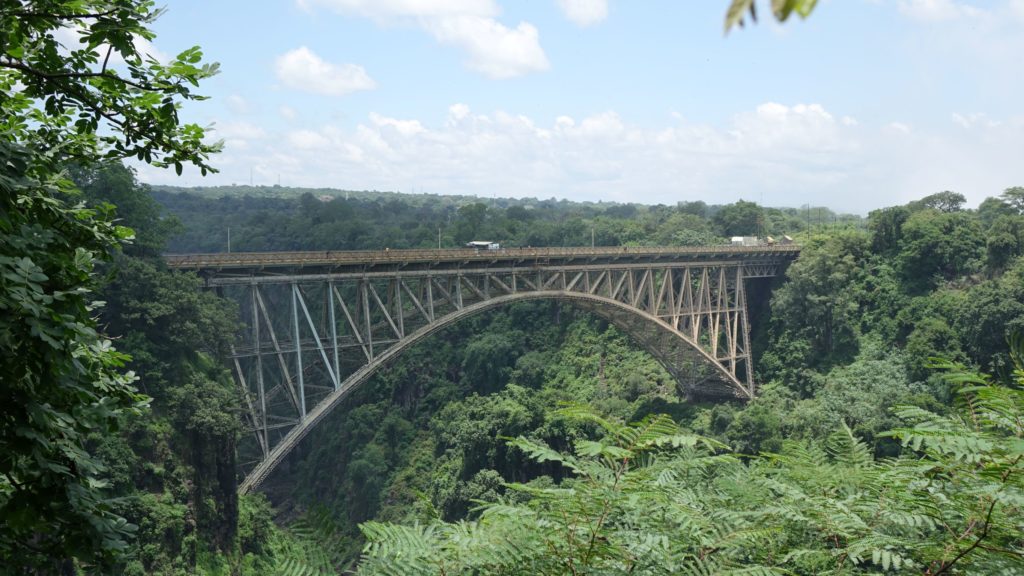
We drive on a beautiful road through the bush, the temperature is pleasant, we enjoy these beautiful landscapes. Suddenly a huge herd of impala appears in front of us on the road. We slow down thinking we can take pictures of them, at that moment, a car passes us, heading straight for the herd, honking its horn. The impalas quickly run away.
On the road itself, there are mounds of excrement that suggest the presence of elephants or dinosaurs. A few kilometres further on, a herd of elephants and a herd of giraffes are on the roadside. Waouuu magnificent. We stop to watch them, sitting on our motorbike. An elephant faces me at less than 10 meters. As we had been warned a few weeks earlier to be very wary of elephants, because underneath their peaceful, slow-moving appearance, they can suddenly charge and trample us. I don’t dare take out my camera, which is right in front of me in my tank bag. At first the elephant seems annoyed by my presence, then it seems to calm down. I look behind me, François is busy shooting. I decide to take my camera out, but without taking off my gloves and helmet in case I have to start off in a hurry. I take several pictures and everything goes well. We decide to continue our journey as we are not finished with the borders and it is already late.
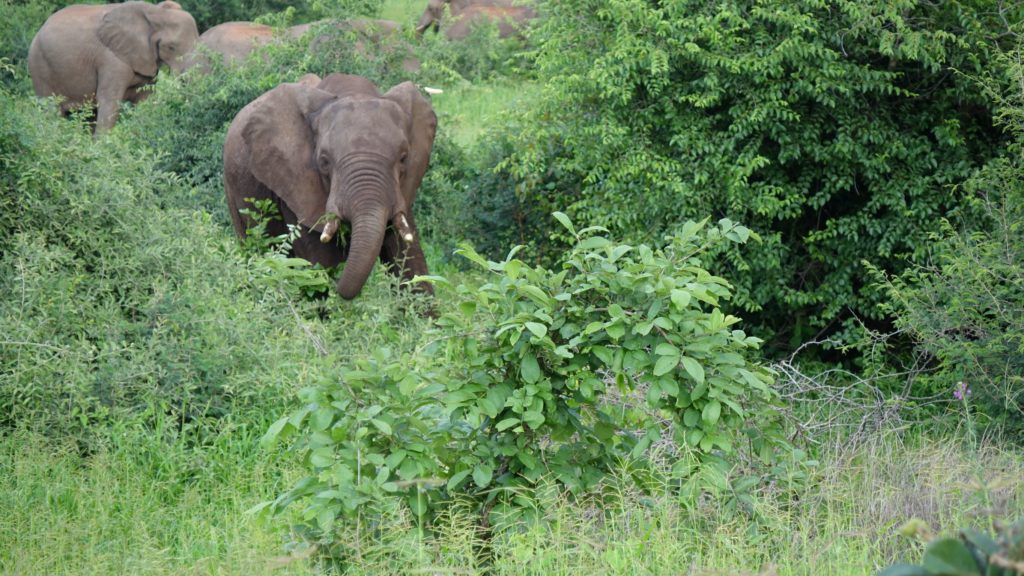
After about 50 km, we reach the Zimbabwean border. Many trucks are stopped on the side of the road. Once again a herd of elephants is on the side of the road, a few meters from the trucks. We take some pictures. A group of young elephants crosses the road in single file, what a sight!
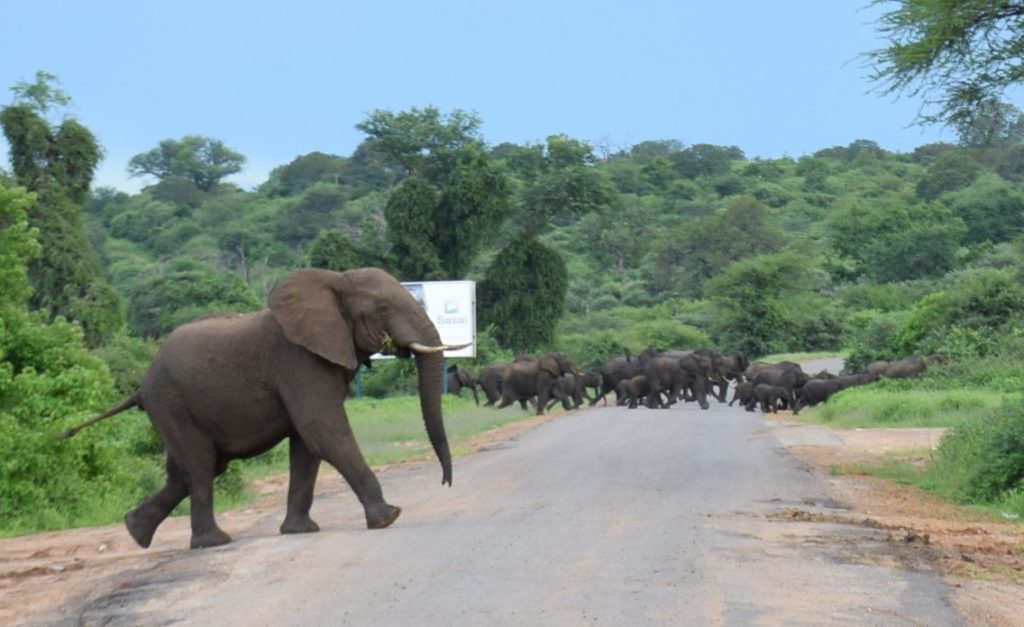
We go to the customs office, and it’s back for a tour, health office, immigration, customs. One of the customs officers takes care of the customs documents, the second one talks to us about motorbikes and shows us on his PC the Triumph he wants to order directly in England. The third one watches a wrestling match on his PC. This time it will be quite quick.
Less than a kilometre away, we still have to cross the Botswana customs. We have to pass with the bike through a huge tub of water with disinfectant. On the other side of the border, an imposing lady makes us understand that we also have to disinfect our shoes. We stand the bikes up and this time we have to go through a tub the size of a doormat. As soon as this is done our matron disappears into the buildings. We pass the health check when suddenly a family of warthogs crosses the border. No PCR test for them, probably regulars! We finish with immigration and customs where we have to pay a visa and a new road tax. We present ourselves at the exit gate as daylight falls. The customs officer draws our attention to the danger of driving at night with wild animals, it is imperative to be careful.
Now it is dark, we walk 15 km to the camp. We sign in at the reception and reach our pitch. We set up our tents which are still waterlogged from our last night of camping three days ago. We are forced to wipe the inside of the tents with our dirty clothes. We spend a night in the humidity and the smell that comes with it.
The next day, in the late afternoon, our friend Victor, who left Cape Town on his motorbike in mid-January, joined us. We celebrate our reunion at the lodge bar under a radiant weather that graces us with a superb sunset, as if to say: “Welcome Victor”.
We will have some surprising visits in the campsite.

Two days later, we decide to stay in a campite recommended by Paul, a friend of François who knows Africa well. Apart from the few kilometres in the sand to get there, what a great place! The camp is located in the middle of nature in front of a large plain dotted with a few trees. No fence separates the camp from the wildlife. It is clearly written in various places that visitors are there at their own risk. There is a watering hole for the animals to drink from. It is located no more than 10 metres from the bar and an observation area without any barriers or protective systems. The watering hole is also equipped with an underground bunker with loopholes through which we can observe and photograph the animals. From this position we are 3 metres away from the waterhole. The animals are sometimes so close that you can reach out through the hole and touch them. It is an incredible experience. The savannah is magical. During the two days we stay there, we see elephants, monkeys, giraffes, impalas, buffaloes, zebras and various birds. We meet a German couple who travel in a 4×4 with a roof tent. They are also amazed by this incredible sight. We feel like we are in the Daktari series from the 60’s (sorry for the younger ones), Clarence didn’t show up though 😉.
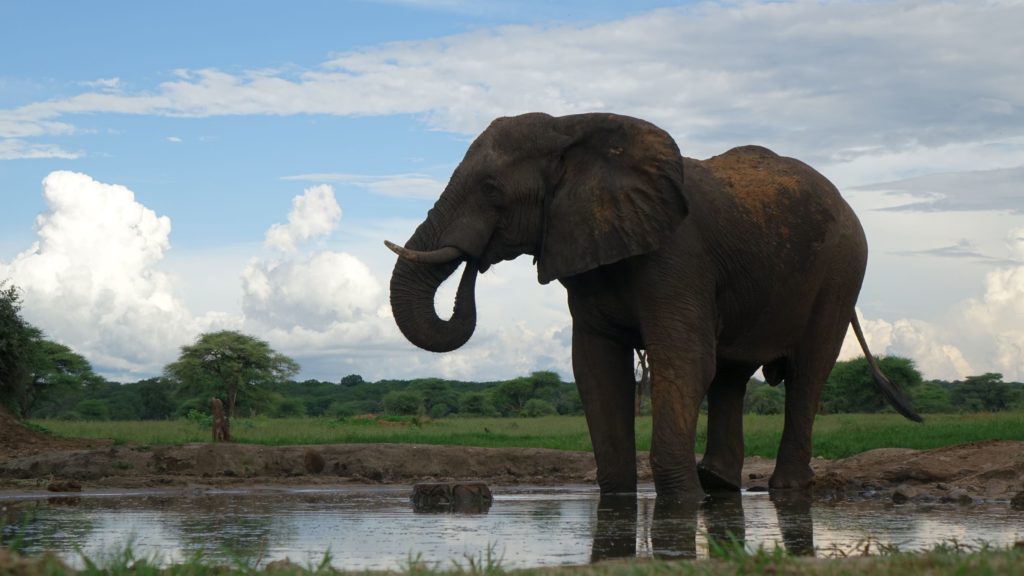
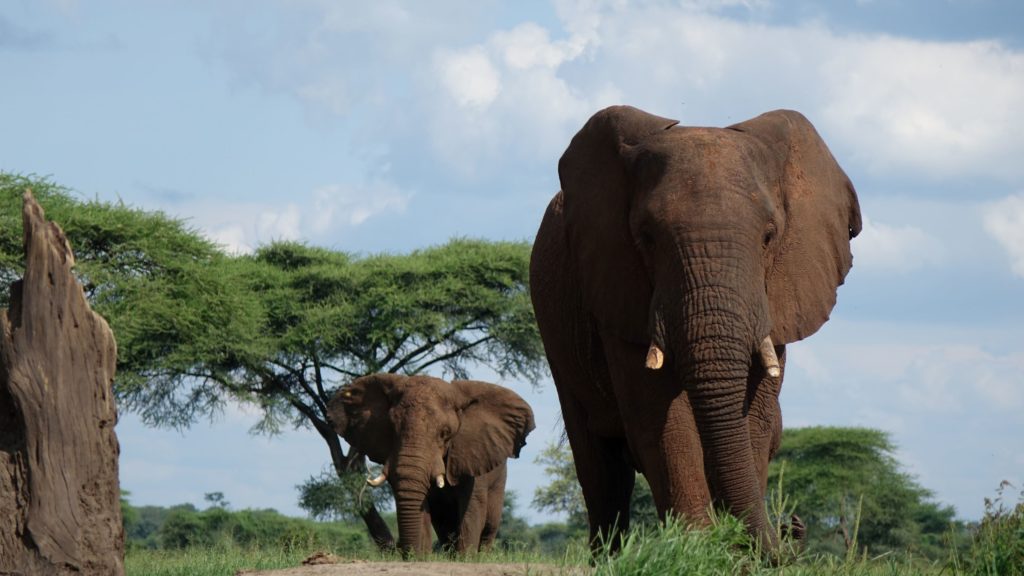
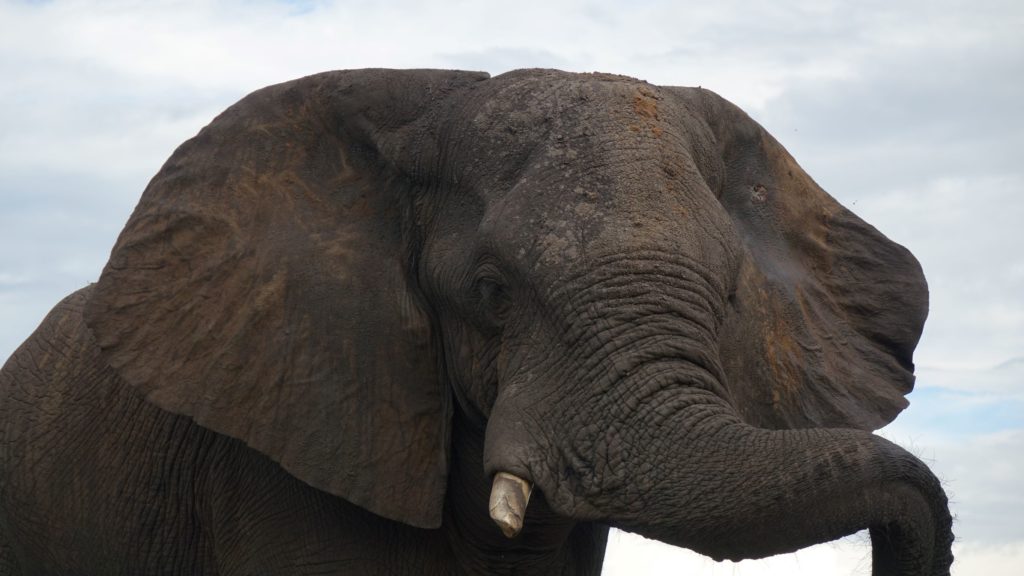
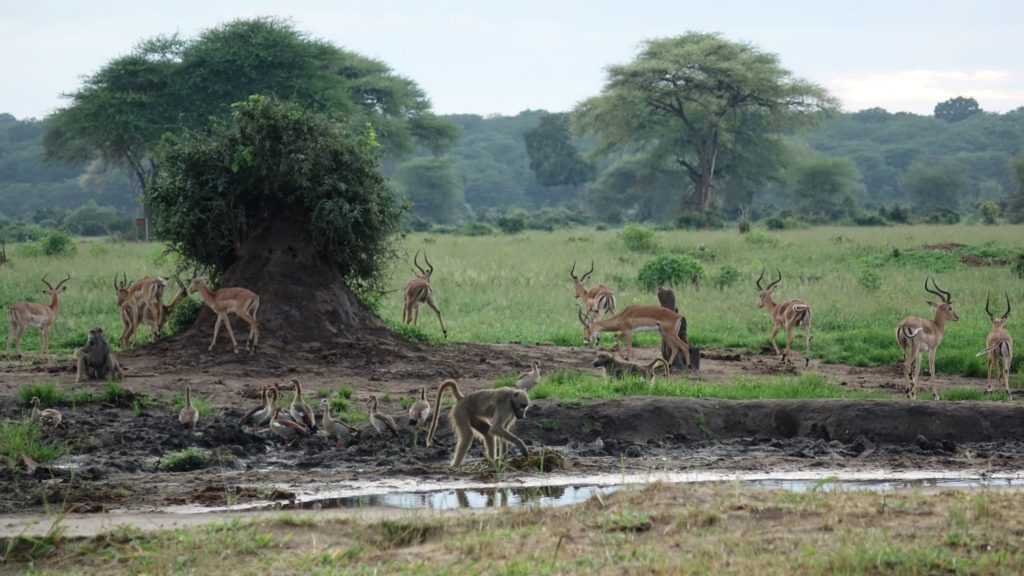
We leave this magical place and head for another camp where it is also possible to observe the animals. On the way we stop at the side of the road in front of a majestic baobab tree. A guard who is passionate about motorbikes comes to meet us. In conversation he asks us where we are going. He tells us that in 30 kilometres there will be no more tar, the road becomes a sand track for 280 km. For him it is not practicable with a motorbike, a 4×4 vehicle is needed. According to our estimates, to reach the campsite we will have to drive 15 km on this track. We decide to go and see how the track is.
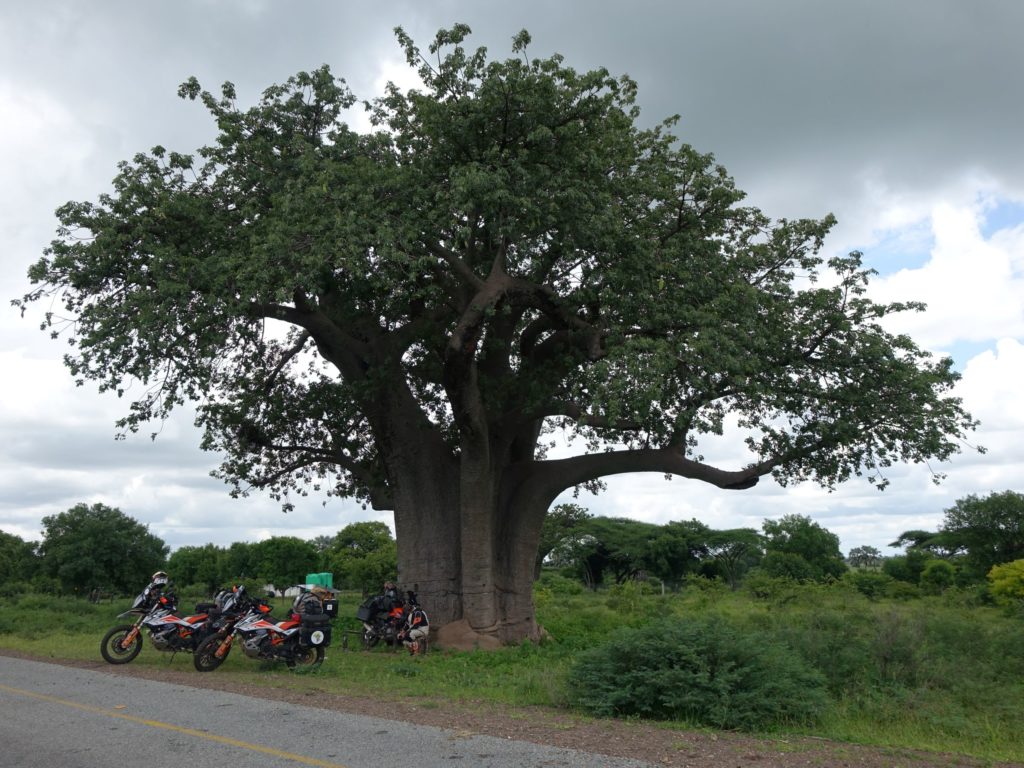
A few kilometres further on, we stop at a bar. We meet some local youths, they confirm what the guard said and add that with the wildlife, riding on this track is not without danger. Most of the wild animals move away when we approach them, however we experienced two days earlier with François that this was not always the case. Indeed, François had stopped along the road to photograph a huge elephant that must have been about 8 meters away. I arrived behind François in freewheel, engine off, to get closer with as little noise as possible. When I arrived at 2 meters from François’ motorbike, I was not yet stopped, here was our elephant showing signs of aggressiveness. We started the engines again and didn’t ask for anything else to save us. It is true that the noise of the engines starting up frightened him and he made a U-turn to leave for the bush.
We continue to this track. It is the width of a car, there is only sand and two ruts. We ride for about 2 km. We stop to take stock of the situation, François wonders if we should continue, Victor wants to continue by taking it easy. For me it’s out of the question, it’s difficult to ride without regularly losing balance and having to recover with the feet with the risk of laying the bike down, but above all the same encounter as two days ago with François on this sandy track where it is impossible to leave quickly and even less possible to make a U-turn, I don’t give a damn about our skin. I am usually consensus oriented, but this time no negotiation is possible, my decision is to turn back.
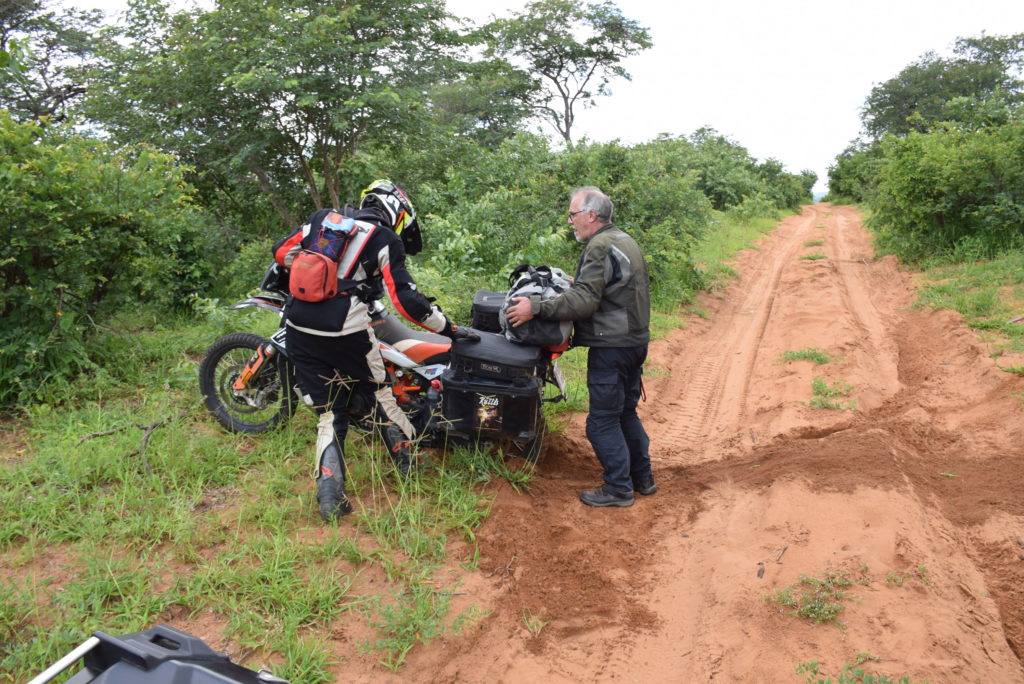
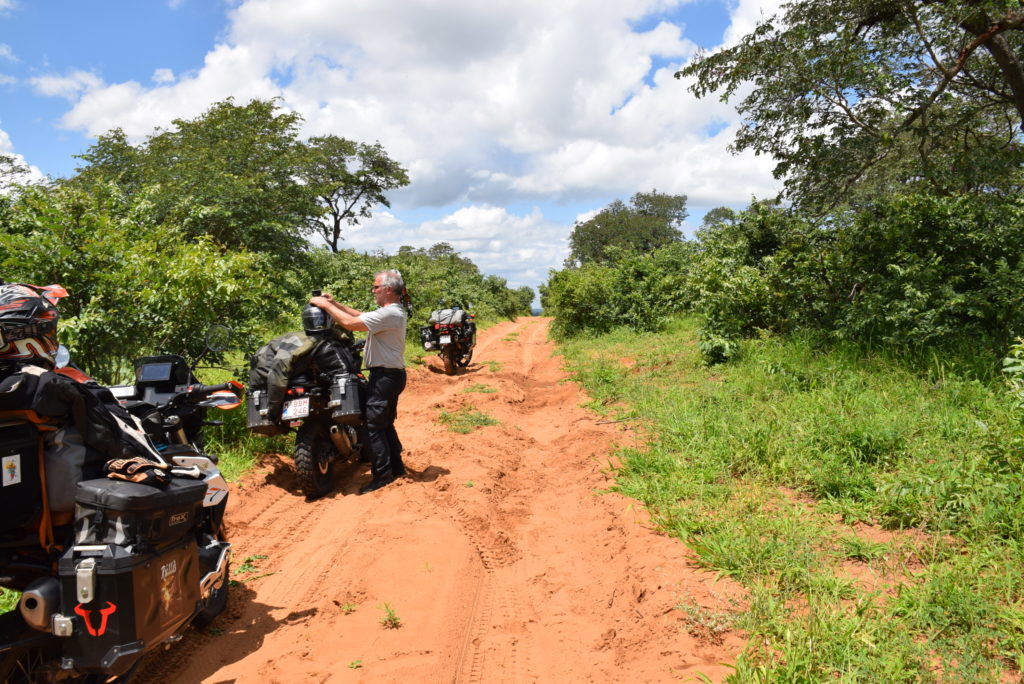
We finally spend the night in a nice campsite a few kilometres away. The area reserved for camping is well shaded, considering the temperatures which exceed 30 degrees it is saving. The camp is secured by an electric fence, so there are no uninvited wild animals. It is an Australian couple who welcomes us, they settled permanently in Namibia 7 years ago now. They are both very pleasant and friendly. The terrace of the bar/restaurant area opens onto a magnificent plain, the calm reigns supreme, it is a very soothing place.
At the end of the day, François and Victor use the maps and GPS to find the best alternative to this 280 km sandy track. What is incredible is that this track is indicated on the map as if it was a tarred road. Reading the comments left on ioverlander about this track, we see that the only vehicles to venture out on it are 4x4s and even for them it is anything but fun. There are not many alternatives, so we decide to go directly to Namibia. We need a PCR test. We’ll take the sample tomorrow morning and report to the border the day after.
On the way to Namibia